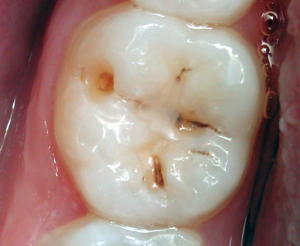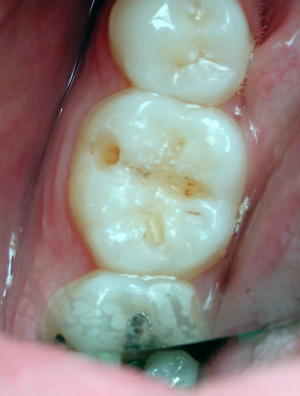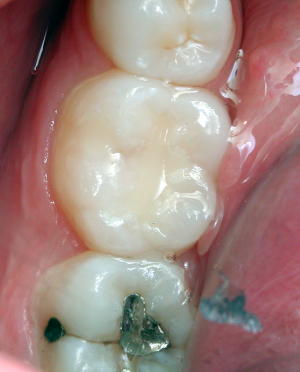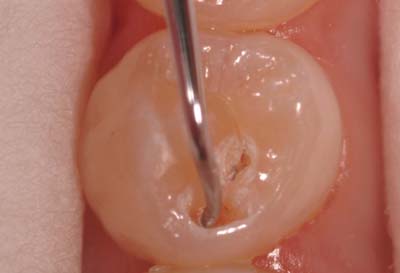Forums › Laser Treatment Tips and Techniques › Hard Tissue Procedures › routine class 1
- This topic is empty.
-
AuthorPosts
-
whitertthSpectatorroutine class 1 restored with renamel flowable…5.5 watts no anesthesia…..remaining discolored dentin wasnt carious… just curious what do u guys do with discolored dentin? remove or leave? hope u enjoy



PatricioSpectatorRon,
My preps look like yours. I check with the small round bur and the explorer and then finish with 1.5w. If the surface is hard and smooth I leave the residual stain.
Pat
AnonymousGuestGreat question , Ron
We started down that road in the microprep discussion and after I posted the following it went nowhere. The studies seem to indicate to me the discoloration shouldn’t be a problem. Anyone else have an opinion/study/input?
Ultraconservative and cariostatic sealed restorations: results at year 10.
Mertz-Fairhurst EJ, Curtis JW Jr, Ergle JW, Rueggeberg FA, Adair SM.
Department of Oral Rehabilitation, Medical College of Georgia, School of Dentistry, Augusta, USA.
Changes in restorative techniques and the development of newer restorative materials have allowed for the use of more conservative cavity preparations. This 10-year study evaluated bonded and sealed composite restorations placed directly over frank cavitated lesions extending into dentin vs. sealed conservative amalgam restorations and conventional unsealed amalgam restorations. The results indicate that both types of sealed restorations exhibited superior clinical performance and longevity compared with unsealed amalgam restorations. Also, the bonded and sealed composite restorations placed over the frank cavitated lesions arrested the clinical progress of these lesions for 10 years.
Publication Types:
Clinical Trial
Randomized Controlled TrialPMID: 9448347 [PubMed – indexed for MEDLINE]
ASDC J Dent Child 1995 Mar-Apr;62(2):97-107 Related Articles, Links
Cariostatic and ultraconservative sealed restorations: nine-year results among children and adults.Mertz-Fairhurst EJ, Adair SM, Sams DR, Curtis JW Jr, Ergle JW, Hawkins KI, Mackert JR Jr, O’Dell NL, Richards EE, Rueggeberg F, et al.
Department of Oral Rehabilitation, School of Dentistry, The Medical College of Georgia, Augusta 30912, USA.
The objective of this clinical study was to evaluate the long-term efficacy of placing sealed posterior composite restorations for arresting active caries. The tooth preparation for this bonded and sealed restoration was limited to placing a bevel in the enamel only, without the removal of the carious lesion. The radiographic and clinical performance of these ultraconservative sealed composite restorations placed over caries (CompS/C) was compared over a period of nine years with: 1) ultraconservative, localized sealed amalgam (AGS) restorations with no extension for prevention, and 2) traditional, unsealed amalgam restorations (AGU) with the usual extension for prevention outline form. Sealant retention with > 50 percent to 100 percent of the margins occurred in 64 percent of CompS/C and 82.5 percent of AGS restorations. After nine years the cumulative failure rates were 16 percent for CompS/C, 2.5 percent for AGS, and 17.1 percent for AGU restorations. Thus, the clinical performance of CompS/C restorations was slightly superior to that of the traditional AGU restorations. The AGS restorations were definitely superior to the traditional AGU restorations and to the CompS/C restorations in both children and adults alike. Complete sealant retention over CompS/C and AGS restorations was equivalent between children and adults (P = 0.14 and 0.74, respectively). A higher percentage of open margins in CompS/C restorations was seen, however, in children (17.4 percent) than adults (1.94 percent). This study has shown that Class I caries can be arrested by the CompS/C restoration.
PMID: 7608378 [PubMed – indexed for MEDLINE]
Glenn van AsSpectatorHi guys: I think that Rons photography is awesome.
Next I would have used a round bur on the buccal as I think that is still decay.
The rest looks awesome.
I hate leaving decay behind and like my continued use of etch in teeth I may be following behind at the ripe ol age of 41.
I am interested to see what others do. i hate leaving decay behind.
Just my .02 cents worth.
Glenn
2thlaserSpectatorHi guys,
I agree Glenn, I try not to leave decay behind, BUT, I don’t use a handpiece that often either. Another suggestion would be to, (which is what I do if I see the above stain after lasering), use a small #4 mini spoon excavator in the lesion, not only to test if its stain, because if it IS stain, the sharp spoon won’t remove anything. BUT if it is decay, you WILL remove dentinal debris, then go back with the laser on a very low setting for just a second to “resterilize, and etch” the dentin surface, and then place your agents and bond.
Here is a picture of one of the microdental spoons I have developed just for this procedure I do.Mark
2thlaserSpectatorI will try to upload the image again, Ron, Help? I don’t know why it won’t upload properly, it’s 89K, so it’s small enough! I renamed it, maybe that will help?
Mark

2thlaserSpectatorSorry about the size of the previous photo, Ron is working on helping this out. I can use a laser pretty good, but it looks like digital reimaging need some work huh?, or shall I say DUH?:confused:
Mark
Glenn van AsSpectatorHi Mark: I think some of your viewpoints may change when you get the scope and see the leathery texture at 10-16X mag of the stain. If you test this stain with caries detector gel it will discolor.
Having said that there is argument as to whether it is necessary to take all the decay out. I hate leaving decay period. If it is a pulp exposure , I want to know.
I also think putting a solid restoration on unsolid foundations (caries) makes the restoration under occlusal forces more prone to leakage.
I think with the laser that it is very easy to leave decay behind because under high mag it is tough to get all the decay out at different angles because the laser is only endcutting.
Mark, keep this post and see if your approach changes (mine did) when you start using the scope routinely. I found often that I would etch a tooth and see that leathery appearance of decay……..shoot. Go back in with a small round bur (when I thought I was done) and then the laser , then re-etch etc.
Glenn
2thlaserSpectatorGlenn,
I believe you! Coming from the wisdom of you and your scope/laser, I can’t wait to get into the learning curve you have already completed. I am sure as I get into more magnification, I will see things much differently. I also know, my goal, to use less rotatry instrumentation, will still be my goal, but to that end, how will the “view” from the scope change my “sight”? That will be the challenge for me. I embrace the challenge, and to that end, the teaching I hope to get from you as I get into the high magnification world of dentistry. Again, thanks for mentoring us all with your wisdom in magnification, and lasers. I know I appreciate it more than anything.
Mark
SwpmnSpectatorI tend to agree with Glenn. If the dentin is discolored, I believe caries remains and we should remove the discoloration. Yes, sometimes I get pulps. Most of the time I get lucky with 3M Vitrebond, Clearfil SE Bond and flowable composite.
When I get deep I use a spoon and 95% of the time can still pick away “infected” discolored dentin with a spoon excavator. I don’t use a round bur because I hate the slow speed but go back in with the Erbium until the dentin is either yellow or red. If red, I use the above mentioned capping technique and inform the patient that the tooth may require root canal therapy.
So far, since May 2001, success rate around 90%.
Al
whitertthSpectatorlooked like decay to me to but i couldnt pick anything with a sharp spoon, didnt fee like it with a round bur and she was starting to get sensitive so ileft it…what do u guys do if in that sitation sensitvity starts..could even go in with one watt and minimal air and water?
Glenn van AsSpectatorHi Ron………dont get me wrong ……..I love your pics and your case.
Given the circumstances I would either go in one with a high speed quickly and say hold on or if you want go in with low laser settings, or leave it and put GI overtop but your case is great and your photos beautiful.
CLAP CLAP CLAP
glenn
dkimmelSpectatorMark, I have been going back though some of the older post and was thinking about something you said the other day about Class 1s. I had just come back from Stewarts course and he likes using air abrasion/fissure burs to open Class 1s. Just a matter of speeding things up. What you said was something about moving quickly through Class 1s. The staff was giving me the look so I had to go and let it drop. How are you doing class one that speed things up?
David
Robert Gregg DDSSpectatorHi Mark,
Nice case.
As another scope guy for about 5-6 years, I agree with Glenn and Allen.
But soon I’m going to post some dentin decay removed with a pulsed Nd:YAG under magnification–just for fun and so Glenn can see it IS so. 😉
Bob
Glenn van AsSpectatorHey Bob………show me the money. Actually, I believe you and when you told me at the CDA that the pulsed Nd Yag wouldnt compare to the Erbium for hard tissue, that was enough for me. The NdYag is a much better laser for perio than the erbium which can also be used in a pocket but not selectively like the Nd Yag for pigmented bacteria.
Glenn
-
AuthorPosts
